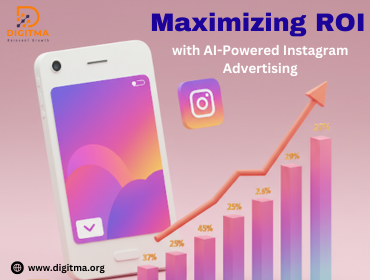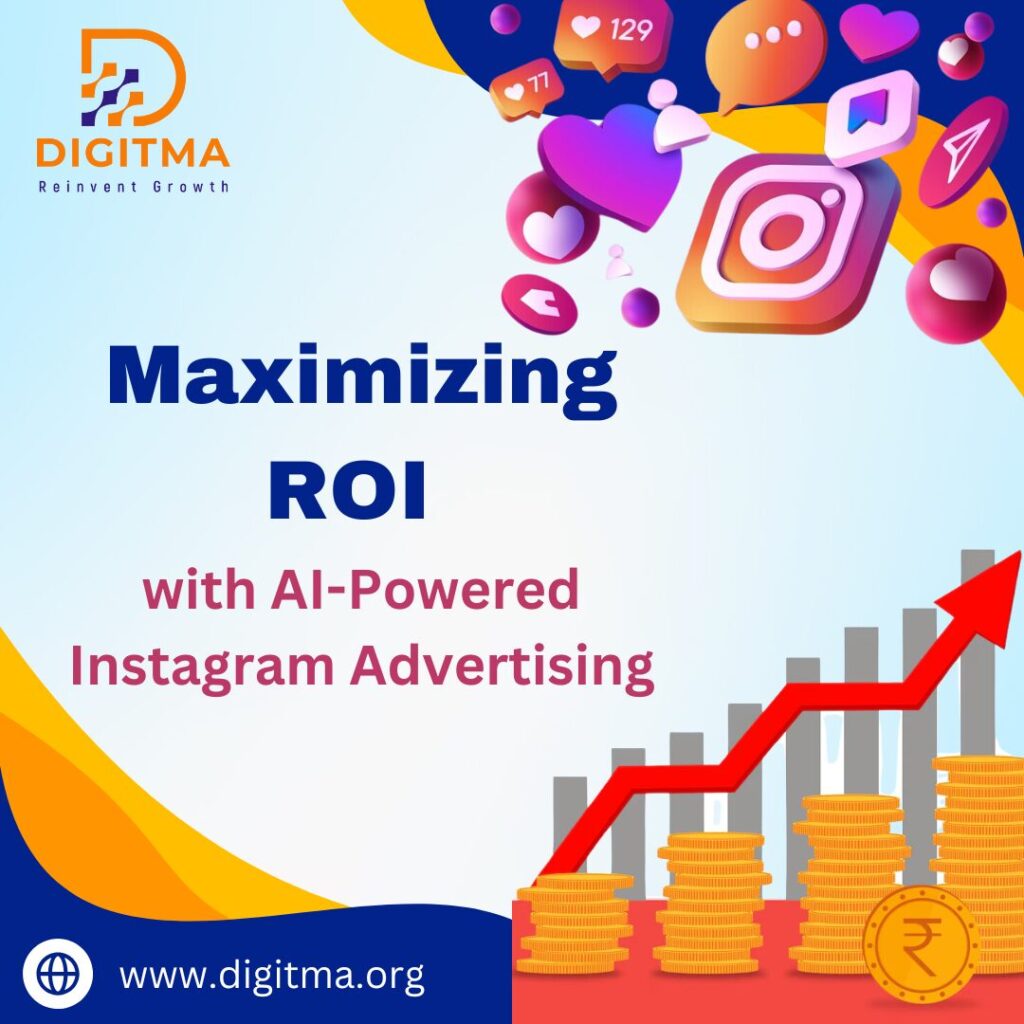
In today’s digital world, Instagram is much more than just a simple photo-sharing app. With over 2 billion active users worldwide, it has grown into a powerful marketing platform for businesses of all sizes. However, because so many brands are competing for attention, it can be challenging to make sure your advertising stands out and delivers the best return on investment (ROI). So, how can businesses succeed in such a crowded space? The answer lies in Artificial Intelligence (AI). Let’s break this down step by step to understand how Instagram advertising works and how AI can help businesses achieve better results.

What is Instagram Advertising?
First, let’s talk about what Instagram advertising actually is. Instagram advertising allows businesses to promote their products or services through paid ads on the platform. These ads can appear in different places, such as your feed, Stories, the Explore page, and even in Reels. They look similar to regular posts, but they are marked with a “Sponsored” label. The goal of these ads is to reach people who might be interested in what the business offers, even if those people don’t follow the brand yet.
One of the best things about Instagram ads is that businesses can target specific audiences. For example, if you sell sports shoes, you can choose to show your ads only to people who are interested in fitness, sports, or running. This is done using data like age, location, interests, and online behavior. Additionally, businesses can decide how much money they want to spend on ads, making it a flexible option for both small and large companies.
Instagram also offers different ad formats, such as photo ads, video ads, carousel ads (which include multiple images), and Story ads. These options allow brands to get creative and engage users in unique ways. With over 2 billion active users, Instagram advertising is a powerful tool for businesses to increase visibility, attract new customers, and boost sales.
How AI Enhances Instagram Advertising
Now, let’s dive into how AI makes Instagram advertising even more effective. AI is like a super-smart assistant that helps businesses make better decisions and save time. Here’s how it works:
Targeting the Right Audience
AI analyzes user behavior, interests, and demographics to help businesses target the right people. Instead of guessing who might be interested in a product, AI uses data to find potential customers who are more likely to engage with the ads. This process, called predictive targeting, uses machine learning algorithms to study past interactions, online activities, and even purchasing behavior. For example, platforms like Facebook’s Lookalike Audiences feature use AI to identify new audiences similar to a business’s existing customers, increasing the chances of engagement and conversions.
Personalized Content
People are more likely to respond to ads that feel personal and relevant to them. AI helps create personalized ads by understanding what type of content each user prefers. For instance, AI tools can dynamically adjust ad creatives—such as headlines, images, and call-to-action buttons—to match individual interests. According to research by Epsilon, personalized ads can improve consumer engagement rates by up to 80%, highlighting the importance of tailoring marketing strategies to individual preferences.
Optimizing Ad Performance
AI tools can track how ads are performing in real-time, analyzing what’s working and what’s not. This allows businesses to make quick changes to improve results, ensuring that the advertising budget is spent effectively. For example, platforms like Google Ads’ Smart Bidding use real-time data to adjust bids for each auction, maximizing the chances of conversions while minimizing costs. This continuous optimization process helps ads stay relevant and effective throughout the campaign.
Automating Campaigns
Managing multiple ads can be time-consuming, but AI can automate many tasks. For example, AI can handle bidding for ad space, scheduling posts, and even responding to comments. This frees up time for businesses to focus on other important areas, like product development or customer service. Tools like Hootsuite and Buffer use AI to schedule posts at optimal times, engage with audiences, and analyze performance metrics, improving efficiency and ensuring a consistent online presence.
Predictive Analysis
AI doesn’t just react to data—it also predicts future trends. This means businesses can plan their campaigns based on what’s likely to be popular, giving them an edge over competitors. Predictive analytics tools analyze historical data, market trends, and consumer behavior to forecast future outcomes. For example, AI can predict which products will be in demand during specific seasons, allowing businesses to tailor their marketing strategies accordingly. According to Forrester, companies using predictive analytics are 2.9 times more likely to achieve revenue growth above industry averages.
Advanced AI Strategies for Instagram Advertising
AI also offers some advanced strategies that can take Instagram advertising to the next level:
- Dynamic Ad Creation:
AI can generate different versions of ads tailored to specific audiences. This is called dynamic creative optimization (DCO), and it automatically adjusts ad elements like images, videos, headlines, and calls-to-action based on real-time data. For example, if a user frequently engages with travel content, AI might show them a travel-related version of an ad, while showing a different version to someone interested in fashion. - Sentiment Analysis for Better Engagement:
AI-powered sentiment analysis tools help brands understand how audiences feel about their ads and content. By analyzing comments, likes, shares, and direct messages, AI can detect positive, negative, or neutral sentiments. This allows businesses to refine their messaging to align with audience emotions, which can enhance brand loyalty and engagement. - Real-Time A/B Testing:
Traditional A/B testing can be time-consuming, but AI speeds up the process by running multiple ad variations simultaneously and analyzing their performance in real-time. This helps marketers quickly identify the most effective ad creatives, leading to faster optimization and improved ROI.
Challenges in AI-Powered Instagram Advertising
While AI offers many benefits, there are also some challenges to consider:
- Data Privacy Concerns:
AI relies on large amounts of user data to function effectively, which raises questions about how this data is collected, stored, and used. Businesses must ensure they comply with data protection regulations like GDPR to maintain consumer trust. - Over-Reliance on Automation:
While AI can optimize campaigns efficiently, it lacks the human touch needed for creative storytelling and emotional connection. Businesses should strike a balance between automation and human creativity to achieve the best results. - Algorithmic Bias:
AI systems can unintentionally perpetuate biases present in the data they are trained on, leading to unfair targeting or exclusion of certain groups. It’s important for businesses to regularly audit and adjust their AI models to ensure fairness and inclusivity. - High Implementation Costs:
Integrating AI into marketing strategies can be expensive, especially for small businesses. The costs associated with AI tools, training, and maintenance can be a significant barrier. - Technical Challenges:
Implementing AI requires specialized knowledge and skills. Businesses may face difficulties in training staff or hiring experts to manage AI tools effectively.
Why It Matters for ROI
Imagine you run a lemonade stand. If you spend $10 on lemons, sugar, and cups, and you earn $50 from selling lemonade, your profit is $40. In this case, your ROI is 400% because you made $4 for every $1 you spent. Businesses aim for high ROI to ensure their advertising efforts are worthwhile and lead to more sales and profits.
How AI Helps Improve ROI in Instagram Advertising
Artificial Intelligence (AI) is changing how businesses advertise on platforms like Instagram. Here’s how AI can boost ROI:
- Better Targeting of the Right Audience: AI analyzes data to find people who are most likely to be interested in a product or service. For example, if a company sells sports equipment, AI can help target ads to users who follow fitness pages or engage with sports content. This precise targeting reduces wasted ad spend and increases the chances of making a sale.
- Personalized Content: AI can create ads that feel personal to each user. By understanding user preferences and behaviors, AI helps businesses craft messages and visuals that resonate with individuals, leading to higher engagement and conversion rates. For instance, a clothing brand might show different outfits to users based on their past shopping habits.
- Real-Time Performance Tracking: AI tools monitor how ads are performing in real-time. If an ad isn’t doing well, AI can suggest changes to improve its effectiveness. This quick adjustment helps businesses use their advertising budget more wisely, ensuring they get the best possible ROI.
- Automated Campaign Management: Managing multiple ads can be time-consuming. AI automates tasks like scheduling posts, adjusting bids for ad space, and responding to comments. This automation saves time and ensures ads run smoothly, contributing to better ROI.
Real-Life Example: How AI Boosted ROI for a Canadian Artist
Mathieu Laca, a contemporary portrait painter from Quebec, Canada, used Instagram ads to increase his online presence. By turning his popular Instagram posts into ads, he gained over 3,000 new followers and saw a 688% increase in traffic to his website. This case shows how AI-driven Instagram advertising can lead to significant growth and improved ROI.
Challenges in AI-Powered Instagram Advertising
While AI offers many benefits, there are challenges to consider:
- Data Privacy Concerns: AI relies on user data to function effectively. Businesses must handle this data responsibly and comply with privacy laws to maintain consumer trust.
- Over-Reliance on Automation: While AI can automate many tasks, it lacks the human touch needed for creative storytelling and emotional connection. Businesses should balance automation with human creativity to achieve the best results.
- Ethical Considerations: AI can sometimes make decisions that are not transparent or fair. It’s important for businesses to ensure their AI systems are ethical and do not discriminate against certain groups.
Conclusion
AI-powered Instagram advertising is transforming how businesses reach and engage with their audiences. By improving targeting, personalizing content, and automating tasks, AI helps businesses achieve higher ROI. However, it’s crucial to address challenges like data privacy, ethical considerations, and the need for human creativity. By balancing AI capabilities with human insight, businesses can create effective advertising campaigns that resonate with their audience and drive meaningful results.


